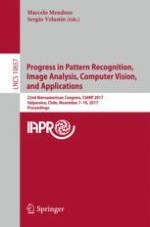2018 | Buch
Progress in Pattern Recognition, Image Analysis, Computer Vision, and Applications
22nd Iberoamerican Congress, CIARP 2017, Valparaíso, Chile, November 7–10, 2017, Proceedings
herausgegeben von: Marcelo Mendoza, Sergio Velastín
Verlag: Springer International Publishing
Buchreihe : Lecture Notes in Computer Science
